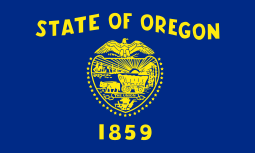Abernethy Bridge
The George Abernethy Bridge,[3] or simply Abernethy Bridge,[1] is a steel plate and box girder bridge that spans the Willamette River between Oregon City and West Linn, Oregon, United States, and which carries Interstate 205. It is also known as the Oregon City Freeway Bridge and the I-205 Bridge.
George Abernethy Bridge | |
|---|---|
 | |
| Coordinates | 45.3645°N 122.6039°W |
| Carries | |
| Crosses | Willamette River |
| Locale | Oregon City, Oregon |
| Owner | Oregon Department of Transportation |
| Characteristics | |
| Design | Box Girder |
| Material | Steel |
| Total length | 2,727 feet (831 m)[1] |
| Longest span | 430 feet (130 m)[1] |
| No. of spans | 15 |
| Clearance below | 85 feet (26 m)[1] |
| History | |
| Construction cost | $15.9 million[1] |
| Opened | May 3, 1970 |
| Statistics | |
| Daily traffic | 102,400 (2004);[1] 95,500 (2008)[2] |

| |
The bridge was opened on May 3, 1970, at a cost of $15.9 million. It is named for George Abernethy, who was the governor of the Provisional Government of the Oregon Country from 1845 to 1849 and later an Oregon City businessman.[1] An approximately $7 million seismic retrofit began in 2000 and was completed in 2002.[1] In 2008, the average traffic was 95,500 vehicles per day.[2]
Description
The bridge structure contains 15 spans and 60 girders.[1] The total length is 2,727 feet (831 metres), and the vertical clearance at low river levels is 85 ft (26 m). The longest span is 430 feet (130 m) and is sandwiched by two 300-foot (91 m) spans.[1] The bridge carries six lanes of traffic (three in each direction—two through lanes, and one merging lane). Interchanges are located at each end of the bridge: On the western end (in West Linn) is an interchange with Oregon Route 43; on the eastern end (in Oregon City) is an interchange with OR 99E. The bridge is somewhat unusual in that its western approach is located on a bluff overlooking the river, whereas the eastern end is located in a lowland just south of the confluence of the Willamette and Clackamas rivers; as a result, westbound traffic on I-205 travels uphill the entire length of the bridge, and continues uphill for another half-mile before the freeway summits and heads back downhill, into the lower Tualatin River basin.
Condition
George Abernethy Bridge appears on the Save Our Bridges map of structurally deficient and fracture critical bridges.[4] Uglybridges.com notes the 2010 National Bridge Inventory in a July 2008 inspection rated its surface as poor (4/9), but said its superstructure and substructure were good (7/9 each). It further noted the foundations were scour critical and unstable and recommended replacement at a cost of $50 million.[5]
In 2009, the Oregon Department of Transportation instead elected to spend $7 million to repave the roadway and replace the expansion joints on the bridge.[3]
In 2017 the Oregon Department of Transportation launched a project to widen I-205 to three lanes between the Abernethy Bridge and Stafford road.[6] Part of the proposed plan includes removing the Highway 43 to I-205 northbound on-ramp and widening the Abernethy bridge.
See also



- List of crossings of the Willamette River
References
- Wood Wortman, Sharon; Wortman, Ed (2006). The Portland Bridge Book (3rd ed.). Urban Adventure Press. pp. 5, 13, 89–94, 157, 184. ISBN 0-9787365-1-6.
- "2008 Traffic Volumes on State Highways" (PDF). Oregon Department of Transportation. August 27, 2009. Page 91: East Portland Freeway No. 64 (I-205). Archived from the original (PDF) on 1 April 2010. Retrieved November 27, 2012.
- "I-205 George Abernethy Bridge Preservation Project". Oregon Department of Transportation. 2009. Retrieved November 27, 2012.
- "LaPanter Bridge Map Overlay for Google Maps: I-205 & Willamette River Bridge Clackamas County, Oregon". saveourbridges.com. Retrieved May 6, 2018.

- "I-205 (Hwy 064) & Willamette River". uglybridges.com. Retrieved May 6, 2018.

- "I-205 Widening and Seismic Improvements: Stafford Road to OR 213". i205corridor.org. Retrieved May 6, 2018.
